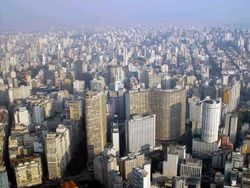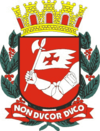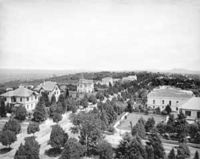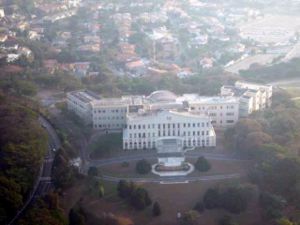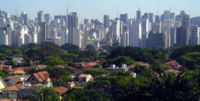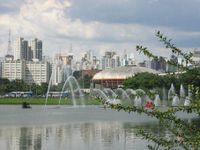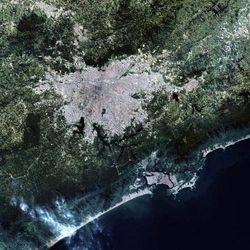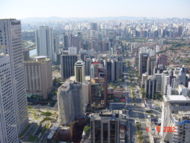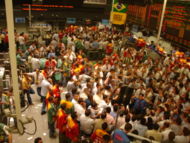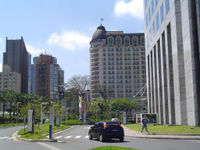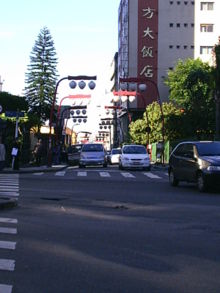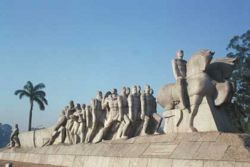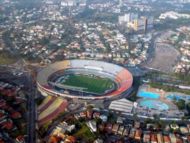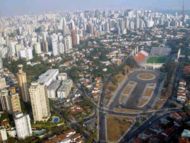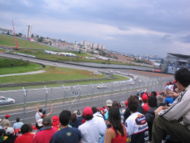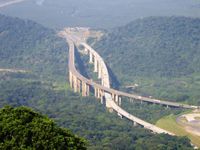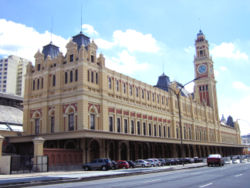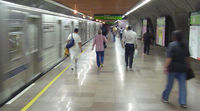São Paulo
2007 Schools Wikipedia Selection. Related subjects: Central & South American Geography
| São Paulo | |||
| Skyline of São Paulo | |||
|
|||
| Motto: Non ducor, duco ( Latin: I am not led, I lead) | |||
| Administrative division of the city | |||
| Country | Brazil | ||
|---|---|---|---|
| Region | Southeast | ||
| State | São Paulo | ||
| Mayor | Gilberto Kassab ( PFL) | ||
| Area | |||
| - City | 1,522.99 km² | ||
| - Metro | 8,051 km² | ||
| Elevation | 760 m | ||
| Population | |||
| - City (2006) | 11,016,703 | ||
| - Density | 7,233/km² | ||
| - Metro | 19,403,480 | ||
| Time zone | UTC-3 ( UTC-3) | ||
| - Summer ( DST) | UTC-2 ( UTC-2) | ||
| Website: São Paulo | |||
São Paulo ( pron. IPA: [sɐ̃w̃ 'paw.lu]; Portuguese for Saint Paul) is the capital of the state of São Paulo in southeastern Brazil. It is located at , 400 km (250 miles) from Rio de Janeiro, and 1,030 km (640 miles) from federal capital Brasília.
The city has an area of 1,523.0 square kilometres (588.0 sq. miles) and a population of just over 11 million (2006 IBGE estimate), which makes it the largest and most populous city in the Southern Hemisphere and a global city.
Nineteen million people live in the greater São Paulo metropolitan area as defined by the government (Região Metropolitana) — making it one of the five most populous in the world. However, when the many adjacent metropolitan areas, such as Baixada Santista, São José dos Campos, Campinas, Sorocaba, etc. are included, such as in the Extended Metropolitan Area (Complexo Metropolitano Estendido) São Paulo, there are nearly 29 million inhabitants, more than any other city in the world except Tokyo, Japan with 35 million. (source: IBGE). The region forms an even larger urban corridor or megalopolis with Rio de Janeiro and Volta Redonda.
The state of São Paulo is also highly populated, however most metropolitan areas hug São Paulo with the exception of Ribeirão Preto. The entire state has a population of over 40 million.
People from the city of São Paulo are called paulistanos, while paulista designates anyone from the whole of São Paulo state, including the paulistanos. The city's motto is Non ducor, duco, which is Latin for "I am not led, I lead". A famous nickname for the city is "Sampa".
History
Jesuit missionaries José de Anchieta and Manoel da Nóbrega founded the village of São Paulo de Piratininga on January 25, 1554. Along with their entourage, they established a mission named Colégio de São Paulo de Piratininga aimed at converting the Tupi-Guarani Native Brazilians to the Catholic religion. Located just beyond the Serra do Mar cliffs, overlooking the port city of Santos, and close to River Tietê, the new settlement became the natural entrance from the South East coast to the vast and fertile plateau to the West that would eventually become the State of São Paulo.
In the 17th and 18th centuries, groups of explorers who named themselves the Bandeirantes browsed forests and new territories within the Latin American continent searching for gold, diamonds and other riches. The Bandeirantes ended up being responsible for a great deal of the Brazilian territorial expansion beyond the Tordesilhas Line and the discovery of many mines of precious metals and stones. There are several monuments in honour of their contribution to the city, including the Monumento às Bandeiras, one of the landmarks of São Paulo.
São Paulo officially became a city in 1711. In the 19th century, it experienced a flourishing economic prosperity, brought about mainly by coffee exports, which were shipped abroad from the port of neighbouring city Santos. After 1881, waves of immigrants from Italy, Japan and many other countries have emigrated to São Paulo in order to work at the enormous coffee plantations established in the State. At the beginning of the 20th century, the coffee cycle had already plummeted due to, among other factors, a sharp decline in international coffee prices. The local enterpreneurs then started investing in the industrial development of São Paulo, attracting new contingents of overseas immigrants to the city.
Another important historical landmark is the University of São Paulo's Law School, also known as Largo São Francisco, claimed to be the first academic institution in Brazil. First installed into a monastery, it was founded on 1 March 1828, right after the beginning of the Brazilian Empire, following the increasing need for lawyers and politicians. As wealthy Brazilians used to go to Portugal to take undergraduate law courses, the Brazilian Emperor, Dom Pedro I, decided that it was time to create a national law school. It attracted students from all over the country, who gave São Paulo a bohemian lifestyle.
In 1972 a fire disaster occurred in Andraus Building and in 1974 in Joelma Building.
Law and Government
Because of its economic and demographic weight, São Paulo has always played a pivotal role in Brazilian politics. With a constituency larger than that of many Brazilian states, the mayor's office is viewed by politicians as a springboard for state and national-level offices.
São Paulo's latest mayors were:
| Mayor | Entry in | Left Office in | Party |
|---|---|---|---|
| Gilberto Kassab | 2006 | - | PFL |
| José Serra | 2005 | 2006 | PSDB |
| Marta Suplicy | 2001 | 2004 | PT |
| Celso Pitta | 1997 | 2000 | PPB and PTN |
| Paulo Maluf | 1993 | 1996 | PDS , PPR and PPB |
| Luiza Erundina | 1989 | 1992 | PT |
| Jânio Quadros | 1986 | 1988 | PTB |
| Mário Covas | 1983 | 1985 | PMDB |
See also: List of Mayors of São Paulo
Geography
Physical setting
São Paulo is located on a plateau that is part of the Serra do Mar (Portuguese for "Sea Range"), itself part of the vast region known as the Brazilian Highlands, with an average elevation around 800m (2,625 ft) - though at a distance of only about 70 km (40mi) from the Atlantic Ocean. This distance is covered by two highways ( Anchieta and Imigrantes, see "Transportation" section below) that roll down the range, leading to the port city of Santos and the beach resort of Guarujá.
Rolling terrain prevails within the urbanized areas of São Paulo, but to the north, the Serra da Cantareira (Cantareira Range) displays higher elevations and a sizable remnant of the Atlantic Rain Forest. The whole region is very tectonically stable, and no significant seismic activity has ever been recorded.
The Tietê River was once a source of freshwater and recreation for São Paulo. However, in the latter half of the 20th century, like its tributary, the Pinheiros, it became grossly polluted by raw sewage and industrial effluents. A substantial clean-up program for both rivers has met with some success. Neither is navigable in the stretch that flows through the city, but transportation is important on the Tietê further downstream, as the river is part of the River Plate basin.
There are no large natural lakes in the region, but the Guarapiranga and Billings reservoirs are used for power generation, water storage, and recreation.
The original flora consisted mainly of a great variety of broadleaf evergreens. Today, non-native species are common, as the mild climate and abundant rainfall permit a multitude of tropical, subtropical and temperate plants to be cultivated, with eucalyptus being especially ubiquitous.
Climate
According the Köppen climate classification São Paulo has a humid subtropical climate. Though generally considered by Brazilians to be drizzly and rather cool, São Paulo's climate is by world standards actually warm and mild. Summer temperatures seldom reach 30°C (86°F) during Summer, while frost is rare during Winter. All-time record temperatures are 35.3ºC in November 15, 1985 and -2.1°C (28°F) in 1918 (in the mountains around the city -3.9ºC were registered in August 2, 1955). Snow flurries were reported officialy just on one occasion in June 25, 1918. Rainfall is abundant, especially in the warmer months, but rare between June and August. Neither São Paulo or the nearby coast has ever been hit by a tropical cyclones, while tornadic activity is uncommon.
| Jan | Feb | Mar | Apr | May | Jun | Jul | Aug | Sep | Oct | Nov | Dec | Year | |
| Avg high °C (°F) | 27 (81) | 28 (83) | 27 (81) | 25 (77) | 23 (74) | 22 (71) | 21 (70) | 23 (73) | 23 (73) | 25 (77) | 26 (78) | 26 (79) | 24 (76) |
| Avg low °C (°F) | 19 (67) | 19 (67) | 18 (66) | 17 (63) | 15 (59) | 13 (56) | 12 (54) | 13 (56) | 14 (57) | 16 (60) | 17 (63) | 18 (65) | 16 (61) |
| Rainfall mm (in.) | 241 (9.5) | 203 (8.0) | 142 (5.6) | 58 (2.3) | 43 (1.7) | 38 (1.5) | 28 (1.1) | 36 (1.4) | 58 (2.3) | 150 (5.9) | 122 (4.8) | 198 (7.8) | 1317 (51.9) |
Metropolitan region
São Paulo is officially inserted in a larger metropolitan region named "Grande São Paulo" ("Greater São Paulo"). The region holds, in total, 39 municipalities and a population of more than 19 million (as of 2005 according to IBGE).
Boroughs
The City of São Paulo is divided into 31 boroughs, or more exactly, subprefectures (in Portuguese subprefeituras), whose names are:
|
|
|
Each subprefecture is divided into several districts (in most cases, two or three). The subprefectures with the greatest number of districts are the boroughs of Sé, in the historical downtown, Butantã, the location of USP, Lapa, Penha and Mooca, all having eleven districts. Well known districts include:
|
|
|
These boroughs are arranged in nine regions, which are the following:
- Centre - the most central borough, it includes only the borough of Sé
- Northeast - residential middle-class area, near the city of Guarulhos, and with a few industries. In this region is placed the intermunicipal bus station and some event places.
- Northwest - it's a poor area, crossed by the railway and roadway to Campinas and other important cities of the state.
- West - It's an important university and cultural region. In this region is placed the Paulista Avenue and most of the luxury neighborhoods.
- Central-South - This region has the highest per capita income of the city. Many offices and brazilian headquarters of multinational companies are settled there. This includes Morumbi, Santo Amaro and Nações Unidas.
- Southeast - Former industrial region, now settled by some "new rich" people. Some important historical boroughs like Ipiranga and Mooca are in this region.
- East 1 - It's a developing region, settled by proletarian and low income people, but with some urban services.
- South and East 2 - The poorest areas of the city, with a large number of people living in favelas and high criminal rate.
Social Policies
In the vicinity of São Paulo are three SOS Children's Villages':
- SOS Children's Village Poá (35km, opened 1968)
- SOS Children's Village São Bernardo do Campo (35km, Riacho Grande, opened 1970)
- SOS Children's Village Rio Bonito (opened 1980)
- Capacity: home of up to 108 children, take care for up to 440 pre-school children, Primary School
Economy
São Paulo is the financial and industrial centre of Latin America. The city is considered to headquarter more German companies than any other single city outside Germany. Likewise, it is also considered to headquarter more American companies among any other city outside the United States. São Paulo's GDP is around US$ 260 billion in 2006 dollars.
São Paulo's stock exchange is the Bovespa, while its futures exchange is BM&F. Its financial districts are located on the surroundings of Avenida Paulista and in the Centro Velho (Old Centre). Other important business districts are located in the boroughs of Pinheiros and Santo Amaro, including the large artery Faria Lima.
There are a number of highly specialised regions, like Bom Retiro and Brás (wholesale garment districts), Consolação (lighting equipment), Rua Santa Ifigênia (electrical and electronic parts), Rua Teodoro Sampaio (furniture and musical equipment), the posh Rua Oscar Freire (designer and label stores), Avenida Europa (automobiles) and the crowded Rua Vinte Cinco de Março. São Paulo is also home to a large number of advertising and broadcasting companies.
In the last few years, São Paulo has become a major home to many international events and fairs, visited by the most varied audiences, ranging from scientists and artists to merchants and entrepreneurs, coming from Brazil and also abroad. Some of the most important events that usually take place in the city are:
- Shoes and Sport Items International Fair - COUROMODA
- Textile Industry International Fair - FENIT
- Construction International Fair
- Shoes, Fashion Accessories and Machines International Fair - FRANCAL
- Cosmethics and Beauty International Fair - COSMETICA
- Lodging-related products, services and equipment International Fair - EQUIPOTEL
- Car International Fair - Salão do Automóvel
- International Book Fair - Bienal Internacional do Livro
There has been a gradual change in the city economic profile since a decade ago, from a strongly industrialized base to service and technology-oriented activity. Intensive manpower-consuming industries have been replaced by a great number of high-technology industries and service providers of many flavours. Business has increased, many new colleges have been founded, and there has been a boom in many sectors, particularly shopping malls, entertainment, construction and business-oriented tourism.
Demographics
São Paulo has significant ethnic diversity in comparison to other major cities:
- 5,000,000 are direct or indirect descendants of Italians. There is a building named Edifício Itália (Italy Building), in honour of the Italians. It was once the tallest building of the city (165m).
- 3,000,000 people are direct or indirect descendants of Portuguese.
- 2,000,000 are direct or indirect descendants of Spaniards.
- 1,500,000 people have direct or indirect African ancestry.
- 1,000,000 people are direct or indirect descendants of Germans.
- 850,000 people are direct or indirect descendants of Lebanese immigrants— by far the largest number of Lebanese outside Lebanon.
- More than 1 million people are direct or indirect descendants of Japanese. São Paulo has the largest number of Japanese outside Japan. The Japanese community's historical centre is the Liberdade neighbourhood.
- São Paulo is home to the largest Jewish community in Brazil with about 130,000 people.
- There is a considerable number of immigrants from other countries in Latin America, especially Argentina, Uruguay, Paraguay, Bolivia, and Chile.
- Note that many paulistanos have mixed ethnic origins; the numbers above may count individuals belonging to multiple groups.
Other sizable groups are:
- Chinese
- Koreans
- Armenians
- Lithuanian
- Greeks
- Syrians
- Polish
Languages
As in the rest of Brazil, Portuguese is the dominant language of the vast majority of the population. However, many other languages, such as German, Japanese, Arabic, Spanish, Chinese, and Korean, are still spoken by first and second-generation members of their respective ethnic communities. Italian (its southern dialects in particular) was once widespread, and though most Italo-Brazilians in the city are no longer fluent in it, typical paulistano Portuguese retains a distinctive Italian cadence.
Education
São Paulo hosts the most well known, and often considered most important, university of Brazil, the University of São Paulo (USP). A public university, maintained by the State of São Paulo USP is free to any student who is accepted. It is one of the largest schools in the country, and boasts large research programs, as well as one of the best educational centers in the country. Located in the city is the main campus as well as the medical and law school. Several smaller campuses are located throughout the state. More than 60% of scientific production came from this institution.
There are a number of private universities throughout the city, and another small public school. As for secondary education, the majority of schools are private, with public schools often being dangerous and not having good education, as well as opportunities for those who graduate from them
Also, Sao Paulo city host the National Institute of Nuclear Research IPEN ( Instituto Nacional de Pesquisas Nucleares) and the biggest public hospital ( Hospital das Clínicas da Faculdade de Medicina da USP).
Sights of Interest
São Paulo is a major cultural centre. The city has an ethnically diverse metropolitan area, with heavy Italian, Spanish, Portuguese, German, Arab and Japanese influences.
The city is known for its varied and sophisticated cuisine, ranging from Chinese to French, from fast food chains to five star restaurants. There are 52 different types of cuisines in São Paulo, and more than 12 thousand restaurants. Other venues such as thousands of bars, pubs, lounges and discos cater to a variety of music tastes.
São Paulo is home to the University of São Paulo and the Federal University of São Paulo, as well as many other private colleges such as the Pontifical Catholic University of São Paulo and Mackenzie Presbyterian University, the latter founded by North American missionaries; two major art museums ( MASP and Pinacoteca do Estado), a major symphonic orchestra ( OSESP), and a Formula One Grand Prix racing circuit ( Interlagos).
There are two major airports in the São Paulo metropolitan area: Governor André Franco Montoro (also known as Guarulhos, neighbour city where it's located, and Cumbica, a district in said city) ( GRU, for domestic and international flights) and Congonhas, insteresting building in the 50's architectural style ( CGH, for domestic flights).
Sights
- Edifício Itália (skyscraper with observation deck)
- Banespa Building (skyscraper with observation deck and museum)
- Pátio do Colégio (founding site of the city)
- Catedral da Sé (the metropolitan cathedral, a symbol of the city)
- Museu Paulista (a museum built in honour of the proclamation of the independence of Brazil)
- Solar da Marquesa (a rare example of 18th century architectural style)
- Paulista Avenue (one of the most important thoroughfares of the city and the site of
many cultural centers and museums, such as the MASP and Centro Cultural Itau)
- Ibirapuera Park (the second largest park of the city (Parque do Carmo is the greatest), is also home to several museums. It is known for its buildings designed by the architect Oscar Niemeyer, such as the OCA and the new Ibirapuera Auditorium)
- Roof floor of Hotel Unique has a spectacular view of the city especially at night
Here is as summary of the events that occur every year or every two years in the São Paulo City:
Festival for Electronic Art
Every two years, Associação Cultural Videobrasil's International Electronic Art Festival brings groundbreaking work by cream-of-the-crop artists from all over the world to São Paulo. In keeping with the constant transformations in media and support, the curatorship has added installations, performances, VJs, CD-ROM art, and internet art to the programme.
The Festival includes a competitive exhibition of so-called southern circuit and an extensive parallel programme. Art shows, debates and meetings introduce new ideas and art work, setting new guidelines for contemporary art in Brazil.
Exhibitions featuring work by prominent electronic artists are also part of the Festival. Brazilian pioneers such as Rafael França and Olhar Eletrônico, and international guests such as Nam June Paik, Bill Viola and Gary Hill, have featured in the event’s past editions. Each edition has a theme of its own.
Bienal de São Paulo
The São Paulo Art Biennial is a cultural event hosted every two years. Almost 1 million people visited the 26th Bienal in 2004.
Its theme was chosen to enable a wide range of artistic positions to feel comfortable. The concept of "Free Territory" involved various dimensions: it had a physical-geographical, a socio-political as well as an aesthetic dimension — the latter, of course, being of greatest interest in the context of this exhibition.
In order to emphasise the thematic unity of the overall exhibition, the invited artists and those representing the countries are mixed together on the 25,000 square metres of the spacious Oscar Niemeyer Pavilion. Despite the complexity of individual voices, the end result was intended to be a unity.
In addition to an intensification of the North-South dialogue inside Brazil, the Bienal's aims include the promoting of links between non-European cultures along a South-South orientation.
São Paulo Fashion Week
Brazil first entered the international fashion circuit with the increasing reputation of famous Brazilian top models such as Adriana Lima, Gisele Bündchen, Fernanda Tavares, Ana Beatriz Barros and Ana Hickmann, and the "discovery" of some fresh talents such as Alexandre Herchcovitch by some international fashion magazines. As a consequence of this, São Paulo Fashion Week is the place to see and to be seen in Brazilian fashion scene, always attracting a number of international editors and models.
Nowadays, São Paulo Fashion Week is one of the most relevant fashion events in Brazil. It takes place twice a year at the building of Bienal de São Paulo.
São Paulo Gay Parade
Also a major event in the city, the São Paulo Gay Parade attracted about 3 million people to Avenida Paulista in 2006, according to official statistics. It is usually opened by the city's mayor. A huge carnival goes all the way through the city centre. The last parade was held on June 17, 2006. It is one of the largest gay pride events in the world.
March For Jesus
The March for Jesus is a Christian parade in Avenida Paulista. In 2005 about 3 million people participated in the event. The first March for Jesus was in 1987 in the city of London, and was established by the pastor Roger Forster, and by the singer and composer Graham Kendrick. In 1998, more than 10 million people in more than 170 nations took part in the event.
Other events
- Anima Mundi Festival
- AnimeCon - International Anime Convention
- AnimeDreams - International Anime Convention
- Comdex
- Mercado Mundo Mix
- São Paulo International Film Festival
- Carnival of São Paulo
- Skol Beats
- Tim Festival
- Festa de N. S. Achiropita
- Video Games Live
Sports
Soccer
As in the rest of Brazil, Soccer is by far the most important sport in the city. The major clubs in São Paulo are Corinthians, Palmeiras and São Paulo. They are all playing in the Brazilian Série A. The fourth club of the city is Portuguesa, currently playing in Brazilian Série B. Another popular club in São Paulo is Santos FC from the nearby coastal city of the same name, Santos. There are two other small clubs in the city, Juventus and Nacional.
Soccer teams
| Club | League | Venue | Established |
|---|---|---|---|
| Palmeiras | Série A | Parque Antártica Stadium | 1914 |
| Corinthians | Série A | Parque São Jorge Stadium | 1910 |
| São Paulo FC | Série A | Morumbi Stadium | 1935 |
| Portuguesa | Série B | Canindé Stadium | 1920 |
| Juventus | Série C | Rua Javari Stadium | 1924 |
| Nacional | Série C | Nicolau Alayon Stadium | 1919 |
Saint Silvester Marathon
The Saint Silvester Marathon takes place every New Year's Eve ( 31 December). It was first held in 1925, when the competitors ran about 8,000 metres around the streets. Since then, the distance raced has varied, and it is now fixed at 15 km. Registration takes place from 1 October, with the maximum number of entrants limited to 15,000.
Brazilian Grand Prix
The Brazilian Grand Prix is a Formula One championship race which occurs at the Autódromo José Carlos Pace in Interlagos.
Other sports
Volleyball, basketball and tennis are other major sports. There are several traditional sports clubs in São Paulo that are home for teams in many championships. The most important are Pinheiros (volleyball, basketball and handball), Paulistano (basketball), Banespa (volleyball), Hebraica (basketball) and São Paulo Athletic Club ( rugby union).
Transportation
The city is crossed by many of the most important roads of the country, such as the BR-116, SP-270, SP-280, Rodovia Anhangüera, Rodovia dos Bandeirantes, Rodovia Anchieta, Rodovia Castelo Branco and Rodovia dos Imigrantes. Some railways also cross the city. They are, however, very old and were constructed intending not to transport people, but to transport coffee to the Santos seaport. However, there are new projects to build new medium-high speed railway tracks from São Paulo to Rio de Janeiro (a project has been announced by the Brazilian government to build a high speed railway service in order to link the country's biggest cities, the trains would go as fast as 280 km/h, and would link São Paulo and Rio in about 1 hour and 30 minutes. These works are still waiting to be officially announced by the government, however some news has been heard on this matter), Campinas and to São Paulo-Guarulhos Airport. The other important project is the "Expresso Bandeirantes", that is a medium speed rail service (about 160 km/h) from São Paulo to Campinas, which would make the journey go from the hour and a half nowadays to about 50 minutes, linking São Paulo, Jundiaí, Campinas Airport, and Campinas city centre. This service is also going to be connected to the railway service that is going to link São Paulo city centre and Guarulhos Airport. Works on this last railway service between São Paulo city centre and Guarulhos Airport were announced to begin in 2007, which is going to be the beginning of the renewal of Brazilian passenger railway service.
São Paulo has three airports. In 2005, about 33 million people passed through the city's airports (mainly from Congonhas and Guarulhos International, the only two operating commercial flights) São Paulo thus contains the most crowded air space both in Latin America and the Southern Hemisphere. Infraero, Brazil's main airport authority, predicts that with the new remodelling of Guarulhos Airport, within five years São Paulo's airports will handle about 45 million. There are also plans to expand the Campinas Viracopos Airport. Campinas is located about 90 km from São Paulo. In about 15 years, São Paulo-Campinas airspace will expand from the 34 million figure nowadays to 100 million. Congonhas Domestic Airport operates domestic and regional flights, mainly to Rio de Janeiro, Belo Horizonte and Brasília. Campo de Marte Airport handles some private and small airplanes. Guarulhos International Airport, known to paulistanos as "Cumbica", located 25 km north east from the city centre in the neighbouring city of Guarulhos, operates domestic and international flights.
São Paulo has the highest per capita helicopter ownership in the developing world and now rivals Tokyo and New York as the world's leading helicopter user. The owners are an elite wealthy class who take advantage of around one hundred helipads and heliports to conveniently avoid heavy traffic and to rise above contact with the more dangerous aspects of urban life.
The city has 60.5 km of underground railway systems (34.6 km fully underground) (the São Paulo Metro, locally known as the Metrô), with 4 lines in operation and 57 stations (33 underground), complemented by another 270 km of CPTM (Companhia de Trens Metropolitanos, or "Company of Metropolitan Trains") railways. Both CPTM and the underground railway lines carry some 3.5 million people on an average weekday, and a few new underground lines to be constructed are expected to add another million people to the system within the next five years. All the main projects from the São Paulo railway and underground system for the next 10 years can be found on the Portuguese pages of the Metrô and CPTM. The projects are said to expand the system from the current 330 km to more than 500 km on the next 10 years.
The bulk of the public transportation (public and private companies) is composed of approximately 17,000 buses, colored uniformily according to the non-central region served (ex.: light green for the buses that go center-southwest, dark blue for northern area). Until recently, there was a strong presence of informal transportation (dab vans), now fully legalized and operating under the same colour scheme of the main system.
São Paulo grew quickly from the 1940s to the 1980s and many roads and buildings were constructed without major planning. As a result, heavy traffic is common in the main avenues of the city, and traffic jams are relatively common in its larger highways. The main means of commuting into the city is by car and by bus. An effective way of avoiding heavy vehicles traffic in the city, such as buses and trucks that crossed the city for other destinations, was planned by ex-governor Mário Covas as a ring of road that circles the city, called Rodoanel Mario Covas, and is currently beeing built by DERSA.
Sister cities
|
|
Current critical problems
Since the beginning of the 20th century, São Paulo has been the major economic centre in Brazil. With the arrival of the two World Wars and the Great Depression, exports of coffee to the United States and Europe were critically affected, leading rich coffee farmers to invest in industrialisation in the city. The new job positions in the industrial sector contributed to attracting many people from other regions of the country, especially from the north east. From a population of merely 32,000 inhabitants in 1880, São Paulo increased its population to approximately 250,000 in 1900, 1,800,000 in 1940, 4,750,000 in 1960 and 8,500,000 in 1980. The effects of this populational boom in the city are:
- Although urbanization plans have been implemented in some areas, São Paulo has developed quickly without major planning.
- Ineffective public transport associated with a high number of cars and other vehicles in circulation lead to consistently congested traffic on many roads of the city.
- Due to heavy usage and poor engineering, the quality of the pavement on certain roads (especially in the outskirts of the city) is problematic, and potholes and other asphalt defects are common.
- Approximately 830,000 people - about 5% of the population - live in slums (favelas) in São Paulo and surrounding regions.
- The so-called PCC ( Primeiro Comando da Capital or First Command of the Capital) is a criminal faction whose terrorist attacks in May and July 2006 shocked its citizens. However, the main target of these attacks were not civilians, but the police and government officials.
- Although there exists several parks across the city, the green area per capita is very small. Because of the lack of developed green spaces and the relative impermeability of the paved ground, floods are common in particular areas. Rain water cannot be drained properly and water accumulates quickly, causing floods mostly during the summer.
- Air pollution is high. The two major rivers crossing the city, River Tietê and River Pinheiros, are severely polluted. A major project intended to clean up these rivers is underway, but complete success is not likely to be achieved for at least 14 years [citation needed].
- Crime rate is high, and many paulistanos have sought personal security by living in gated communities or high-rise secured condominiums.
Famous Paulistanos
- Ayrton Senna
- Rubens Barrichello
- Leandro Barbosa
- Gustavo Borges
- Luciano Burti
- Cafu
- Hélio Castroneves
- Mário de Andrade
- Oswald de Andrade
- Emerson Fittipaldi
- Eder Jofre
- Amyr Klink
- Anita Malfatti
- Felipe Massa
- Fernando Meirelles
- Nenê
- José Carlos Pace
- Rivelino
- Robert Scheidt
- Ricardo Semler
- Fernando Meligeni
- Miguel Kohlmann
Major holidays
- January 1 – New Year
- January 25 – São Paulo's Anniversary — city holiday
- Between February and March – Carnival (Brazilian national holiday, it starts on the Friday to Tuesday preceding Lent. The holiday ends at noon on Ash Wednesday)
- Easter
- April 21 – Tiradentes
- May 1 – Labour Day
- Second Sunday in May – Mother's Day
- Between May and June – Corpus Christi
- July 9 – Constitutional Revolution of 1932
- Second Sunday in August – Father's Day
- September 7 – Brazil Independence Day
- October 12 – Our Lady's Day/ Children's Day
- November 2 – All Souls' Day
- November 15 – Republic Day
- November 20 – Afro-Brasilian's Consience Day
- December 25 – Christmas
